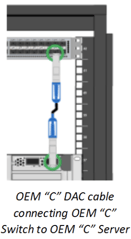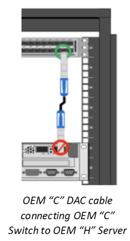 Top-of-Rack (ToR) data center designs are credited for simplifying data center deployments. Reduced cabling costs and easy integration of modular rack-and-stack cabinets are key drivers for the adoption of ToR data center designs. ToR "direct connects" network elements within a rack to a 1U or 2U switch installed at the top of the rack. ToR typically uses lower-cost copper Direct Attached Cables (DACs) to offer cost effective in-cabinet cabling in comparison to designs that run bundles of cables from one cabinet to the next.
Top-of-Rack (ToR) data center designs are credited for simplifying data center deployments. Reduced cabling costs and easy integration of modular rack-and-stack cabinets are key drivers for the adoption of ToR data center designs. ToR "direct connects" network elements within a rack to a 1U or 2U switch installed at the top of the rack. ToR typically uses lower-cost copper Direct Attached Cables (DACs) to offer cost effective in-cabinet cabling in comparison to designs that run bundles of cables from one cabinet to the next.
Direct connecting switches, servers and other appliances pose the challenge of interoperability. Interoperability in a ToR environment refers directly to the compatibility of DACs connecting devices from different OEMs. Top of Row deployments that mix switches, servers, load balancers or storage appliances from multiple OEMs must address the challenge of interoperability.

Many OEM switches and servers require proprietary cables to ensure compatibility. When plugging an OEM (let's call this OEM "C") DAC into a switch, the user expects a plug and play experience, that the switch will see the cable and not present any alarms. No additional work around commands or special action should be taken.
However, if the user were to take the other end of the cable and plug it into a server from OEM "H," the server may not see the cable or may present messages or errors that may be picked up by network monitoring tools. Dominant OEM network equipment vendors are in the business to sell their exclusive ecosystem. They do not offer a solution to ensure interoperability across multiple OEM hardware elements in a direct connect scenario.
Luckily, third-party solutions are available to solve this interoperability challenge. DACs and AOCs can be programmed in the factory for compatibility to each OEM; additionally, each end can be programmed for a different OEM.

The hybrid or multicode DAC solution offers assurance that multi-vendor connections are plug and play. Even 40G/100G breakout connections for multiple OEMs can be supported by hybrid cables coded for multiple OEMs. Each end on these breakout cables can be programmed for a different OEM if the application warrants!

Third party suppliers have experience in programming pluggable cables and transceivers to work seamlessly with OEM switches and servers. Third party pluggable DACs programmed for multiple suppliers give data center operators a robust set of tools to ensure interoperability in Top-of-Rack environments.
Click here to learn more about ProLabs.
Click here to contact your local Accu-Tech representative.
Content provided by Ray Hagan, ProLabs.


.png?width=58&height=58&name=X_logo_2023_(white).png)
